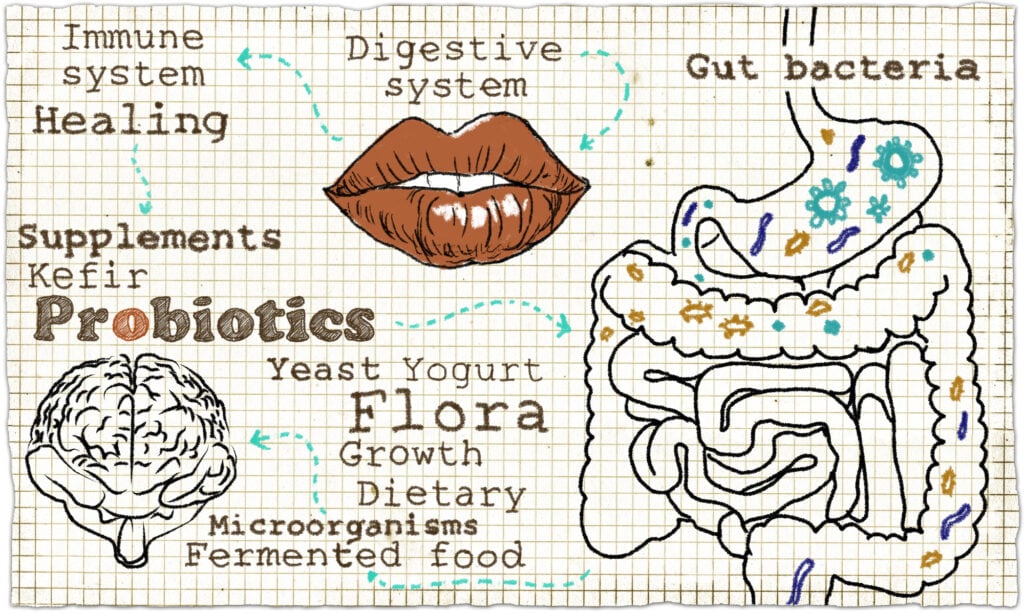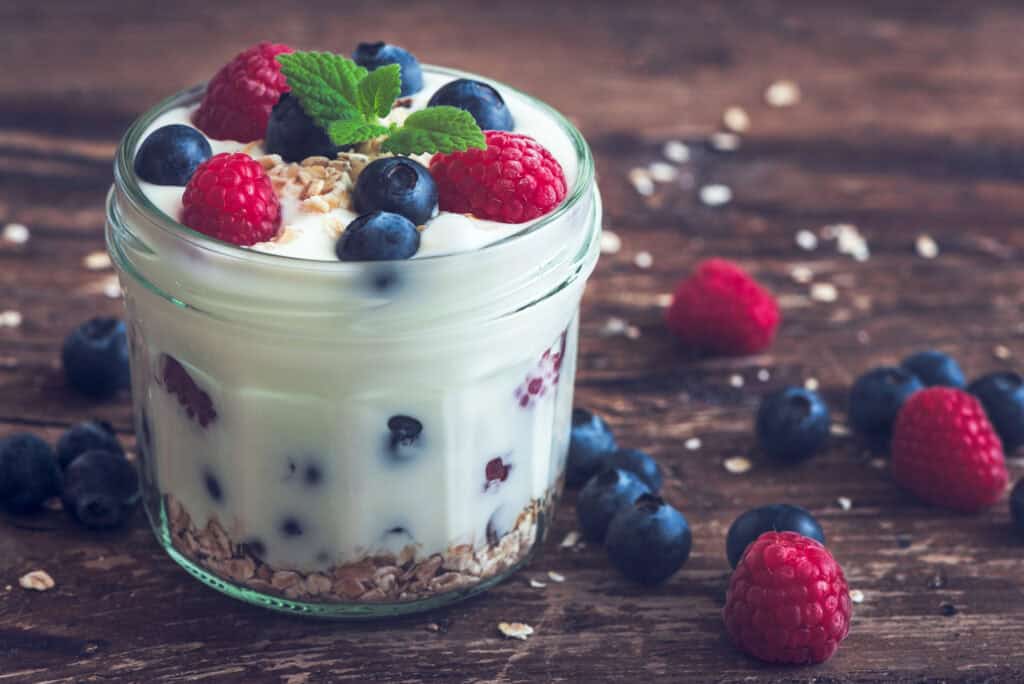EDITOR’S SUMMARY: As is the case with many foods, deciphering health claims, and understanding manufacturer packaging messaging can be tricky. This often calls for deeper investigation, while rejecting blind trust. Similar to boxed breakfast cereals, the alluring design and advertising on yogurt containers is wildly colorful. This is important to realize because the quality of the yogurt you consume will make the difference between a health-promoting, gut-enhancing food, and a heavily-processed, nutrient-deficient metabolic catastrophe.
By Brynnae Beekind
Yogurt has been promoted as a healthy addition to your diet, yet also ridiculed for its sugar and fat content. So, which is it? You may have read articles or heard news stories telling you to avoid “fruit at the bottom” varieties, dairy-based, or full fat options. Different brands create clever marketing campaigns to steer you toward trying their product and getting you hooked. These are typically yogurts with a sweet taste, smooth mouthfeel, and a claim of containing probiotics for your gut health. But the truth about the health benefits of yogurt rely on what happens when you consume a quality product. Without investigation, you might believe yogurt to be an ancient food made by a process of spoiling milk, where good bacteria grow and create the health properties associated with it. In reality, it’s not too far off. Although in today’s world, yogurt is made in a variety of ways, with different types of milks, additives such as sugar and thickeners, and bacterial strains.
In the simplest commercial method, milk is heated and cooled, manufactured bacterial strains are added, and the mixture sits for several hours or longer to let the magic happen. This process causes a thickening and a souring of the milk by way of the proliferation of multiplying Lactobacillus bulgaricus and Streptococcus thermophilus bacteria, which essentially consume the lactose sugars in the milk. Lactose sugar is naturally occurring as a disaccharide, made up of glucose and galactose. You may recognize this process of making yogurt as a type of fermentation. When milk is properly fermented, it loses that slightly sweet taste in place of a sour one. In Greek style yogurt, the whey (liquid milk protein) is strained out, making an even thicker concoction.
When plain dairy yogurt is labeled as full fat or whole milk, the absorption of remaining lactose sugar is slowed in the body. This gradual carbohydrate conversion into your blood results from combining fat, protein, and/or fiber, and creates a lower glycemic response. Full fat yogurt is high in both fat and protein, making it an ideal food even if you have glucose sensitivities. When low-fat yogurt is eaten, your blood glucose level will likely spike higher than if you ate a full fat version. The removal of fat generally results in a less palatable product. As such, it leads commercial manufacturers to add sugar and syrupy fruit to sweeten the deal. Sugar is known to cause inflammation, and consistent consumption of sugar-laden foods leads to chronic, low-grade inflammation that contributes to a variety of health issues, including type 2 diabetes, arthritis, heart disease, and cancer.
While dairy-based yogurts typically line the grocery store shelves, non-dairy options such as coconut, soy, cashew, almond, and oat milk are available too. These nut/legume/cereal grain-based varieties can be highly-processed, and may contain a good amount of natural and/or added sugars. The benefits of the non-dairy yogurts come by way of increased fiber content, but they typically lack the protein and calcium levels that dairy has to offer. Dairy options, however, are more likely to be fortified with synthetic vitamins, or come from cows treated with antibiotics. Additionally, cow’s milk yogurt may come from a breed that produces the casein A1 protein. Research suggests a link between this protein and gastrointestinal inflammation, decreases in cognitive functioning, and GI discomfort. Interestingly, mammals that produce milk with the casein A2 protein, which has not been shown to cause the same upsets, can be found in human breast milk, Guernsey, Jersey, Charolais, and Limousin cow breeds, as well as goat, sheep, and buffalo. This suggests that choosing yogurt from these animals may reduce your chance of adverse effects. While milk from the cow breeds may produce a largely similar yogurt, sheep and goat milk yogurts tend to be more sour tasting.
According to the U.S. Food and Drug Administration (FDA), packaging may display the term “contains live and active cultures” if there is a minimum of 1 million colony forming units (CFUs) of bacteria per gram of yogurt that will remain alive for the shelf life of the product. To put this in perspective, a typical serving of yogurt hovers around 140 grams (5 oz). The minimum number of CFUs in this serving size would be around 140 million. Many popular and robustly manufactured probiotic supplements contain billions of viable bacteria per serving. While yogurt may not serve the same punch of bacteria that a high-quality supplement will, the price point is typically more agreeable. And consuming low-sugar fermented foods on a regular basis has been proven to positively affect your gut microbiome, support healthy blood pressure, and protect against eczema and asthma.

Pre-, Pro-, and Postbiotics
Whether you choose animal-based or non-dairy yogurt, it’s important to know what contributes to the most beneficial outcomes for your body, other than simply selecting a plain or no-sugar option. This is where different bacterial strains, prebiotics, and postbiotics become important. The various live bacterial strains added to yogurt that have been shown to be beneficial to its hosts are called probiotics. This officially-recognized definition of a probiotic has been largely agreed upon by experts in gastroenterology, family medicine, gut microbiota, and immunology, etc. The problem here is that the types of bacterial strains present in the human body are vast. You have ten times more microbiota on and in your body than you do human cells. And up until recently, the most researched strains were disease-causing, such as E. coli and C. diff. The Human Microbiome Project has helped pave the way for the study of “good bacteria.” With only a small number of strains having been studied for their healthful benefits, there is currently a finite number of recognized probiotics. This list will undoubtedly grow as more research is conducted.
Many of the lower cost yogurt options that contain live bacteria generally only contain the minimum amount of CFUs unless otherwise noted on the label. The main two probiotics present in all yogurts that say “contains live and active cultures”—Lactobacillus bulgaricus (L. bulgaricus) and Streptococcus thermophilus (S. thermophilus)—aid digestion by enhancing metabolism of nutrients. Many of the other strains added to yogurt, like L. Casei, L. Rhamnosus, and L. Acidophilus can help support a healthy immune system and regular bowel movements. The name of the game is diversity. The more probiotic strains you can get in your yogurt, the better. While many strains overlap in their beneficial effects, each specific strain has been studied for specific benefits to your body. Dannon, a well-known brand in the U.S., contains only these basic strains in their plain yogurt. The most popular brand of yogurt in the U.S., Chobani, includes the basic probiotics in their plain yogurt, along with Lactobacillus acidophilus, Bifidus, Lactobacillus casei, and Lactobacillus rhamnosus. More costly, an organic brand such as The Coconut Cult, boasts a whopping 16 strains of probiotics, and a minimum of 50 billion CFUs per ounce. You can see that not all brands of yogurt are created equally.

A Bit of Physiology
What happens after you take that bite of yogurt is debatable, but many experts believe that the beneficial microbes are deposited throughout your digestive system. Some bacteria may be sensitive to acid or oxygen and die off. Some will take residence in your mouth, stomach, or small intestine, and others make it all the way to the large intestine, where the majority of your gut microbiota live. Consuming a wide variety of probiotic strains in fermented foods such as yogurt helps to ensure that they get to a place in your gut where they can survive. The thriving of bacteria is determined by several factors including the amount of prebiotics present in your system. Prebiotics are simply what your good bacteria eat to stay alive and proliferate. This includes fiber from complex carbohydrates. Eating a variety of organic vegetables, legumes, and fruit helps maintain a healthy gut microbiome, and slows the dying off of your good bacteria. Coconut, almond, and Greek yogurts have the added benefit of being a synbiotic, that is, they contain both probiotics and prebiotics by way of carbohydrate content, and have been researched for their improvement of oxidative stress, and reduction of risk for insulin resistance, a precursor to type 2 diabetes.
That said, you can add fiber to any type of yogurt. This includes fruit, hemp seeds, flax, nuts, or other plant foods that give your gut bacteria something to eat as soon as they land along your digestive tract. Yogurt also contains postbiotics, the beneficial end products largely created by good bacteria. Because yogurt is fermented, the living bacteria are already making these end products before you consume it. Lactic acid is the main postbiotic found in yogurt itself. It has antimicrobial properties that can help keep bad bacteria, like E. coli, at bay. Eating yogurt can help heal and prevent leaky gut syndrome, a common condition in the U.S. Once you ingest a high-quality yogurt (organic, full fat, no additives), and the probiotics set up shop in your digestive tract, they eat the fiber you feed them, and produce more postbiotics.
Aside from promoting regular bowel movements, their benefits include boosts to the immune system, and anti-tumor properties. Consuming yogurt can also help you maintain healthy blood glucose levels and reduce your risk of type 2 diabetes. According to Frank Hu, professor of nutrition and epidemiology at Harvard School of Public Health, “… probiotics in yogurt may may help improve insulin sensitivity and reduce inflammation,” although he believes more clinical trials are needed. This indicates that the benefits of probiotic-rich yogurts rest in their ability to produce these beneficial postbiotics.
Given the research, it’s safe to say that yogurt is much more than a trendy health food. Its rich, creamy deliciousness can pack a powerhouse of benefits linked to bowel regularity, lower instances of type 2 diabetes, reduced cancer risk, heightened immunity, and anti-inflammation. Organic, whole, grass-fed/pasture-raised (if animal-based), non-additive, sugar-free yogurt options that list the live probiotics right on the label, or are easily accessible on their website, are your best bet for improved health. You may also consider making yogurt at home by mixing your milk of choice with a store bought, plain yogurt for the initial bacterial infusion. Making your own allows you to control the process and customize it to your liking. Raw milk yogurts are difficult to find, so if you prefer those extra enzymes, you can try your hand at creating low temperature yogurt right from your kitchen. Pair your favorite yogurt with good sources of fiber to create a pre- and probiotic miracle food that adds disease-fighting postbiotics to your daily regimen, and enjoy every nutritious bite.
~
Published on October 24, 2024.
If you’ve found value in this article, please share it!
To support the research and health education of AVFC editorial, please consider making a donation today. Thank you.

